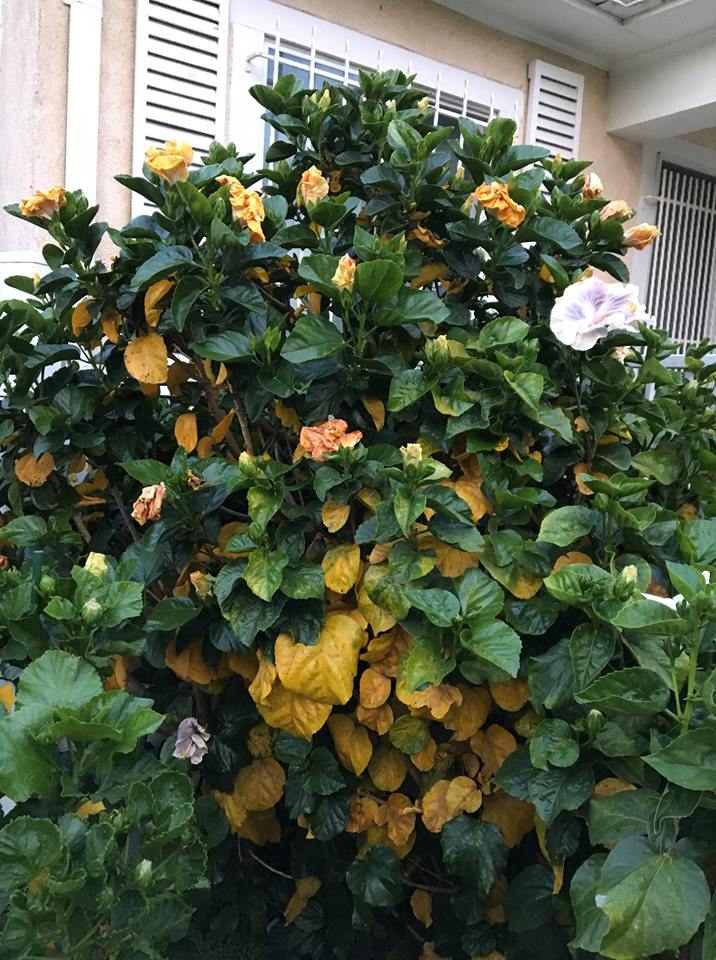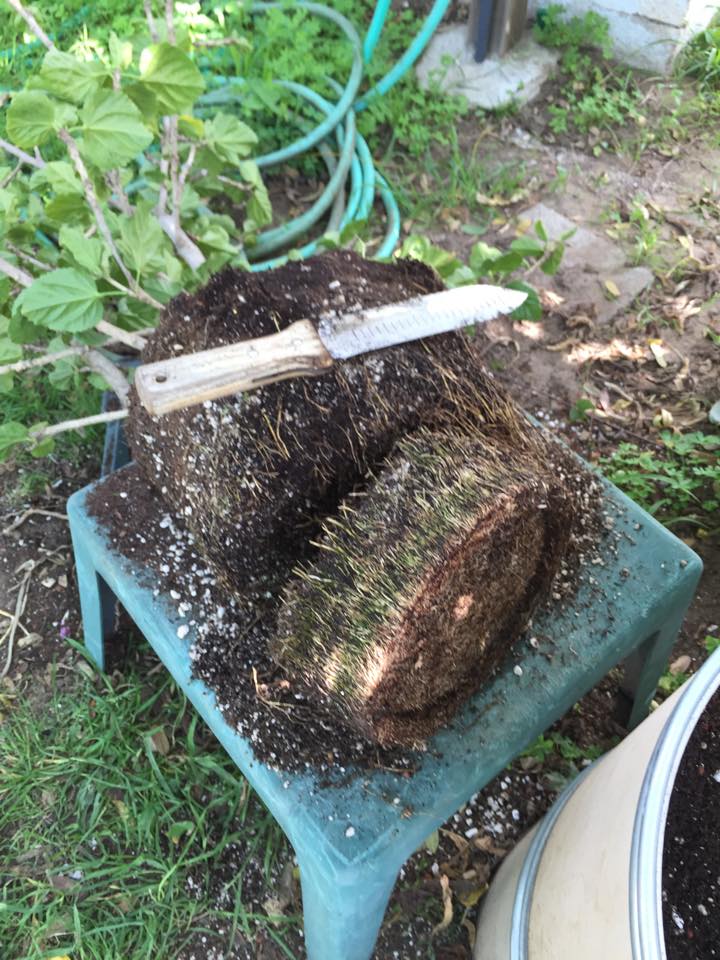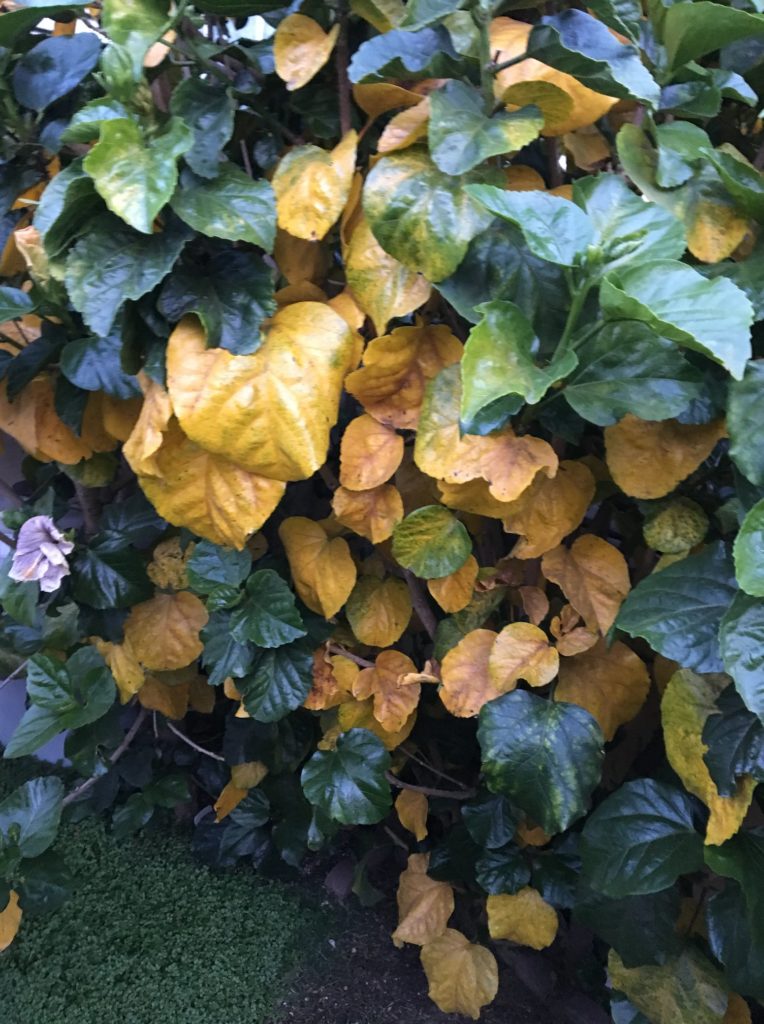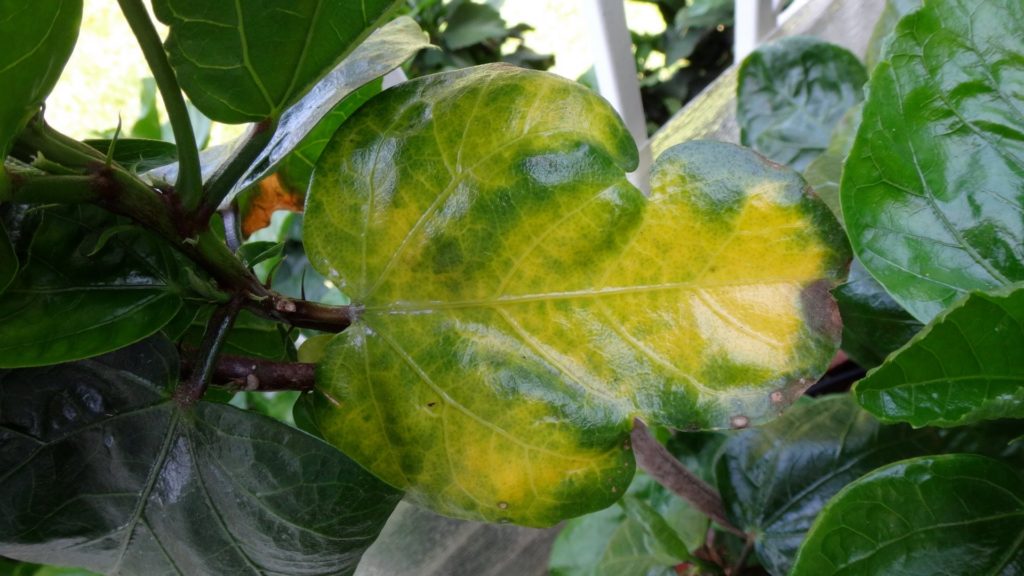Yellow Leaves & Brown Spots
Yellow leaves on your hibiscus can occur for a variety of reasons and as a good grower it is crucial that you understand what you are seeing and what the cause is. As stated in our webpage The Golden Rule it is an essential part your grower’s skillset to always be aware of what has been going on with your hibiscus plants 2-3 weeks prior to properly diagnose the cause of any current yellow leaves.

The above photo is a good way to show how we can use clues from your plant to determine what is going on.
Veiny Top Leaves & Yellow Leaves Below
The first thing a grower needs to look for when yellow leaves appear is the condition of the top leaves on their plant’s branches. If the leaves look veiny and chlorotic that is a sign that your plant is getting too much water and/or the soil does not have enough air in it. If this is the case then you need to immediately back off watering your plant.
The second thing to do is inspect your soil mix to see if you need to replace it with one that is much more full of air and better draining. Sometimes you will have the right soil mix but the root space is too constrained and/or there is something near by that is giving too much water for your plant. Native soils like clay are great at causing this too so make sure your hole you dug is large and deep enough. For potted plants this could be a sign that your plant has outgrown it’s pot and/or it has become root bound. Root bound plants will lack enough soil and probably have plugged up all the drainage holes with their roots. Time to pot up your plant to a larger size pot or root prune. Check out our root pruning video: Root Pruning Video.

If you see veiny leaves on top and you have branch tips dying back that is a much more serious problem. That usually means you have some form of root rot going on and as the infection spreads inside the plant it will continue to block the nutrient uptake channels disabling your plant from not supporting it’s daily functions causing parts of the plant to start to die. This is the worst and most serious problem your plant can face in Southern California and needs immediate action if not too late already. See our webpage: Branch Tip Dieback
Yellow Leaves from Spring
In Southern California we typically see our first spring growth spurts for hibiscus in February. That can be a bit earlier if we have a warm and dry winter or much later if we have a long wet, cold winter then we might not see spring growth spurts until mid April. What your plant is doing is going through a releafing cycle where it will replace all of last year’s leaves with new ones or with branches which is a great sign.
The tricky part about identifying if this is the case is some plants depending on their genetic makeup will not show the new baby leaves at the leaf nodes until the current leaf has yellowed and fallen off. Other plants will show the baby leaf while the current leaf is still attached. So if it is late winter or spring and you start to see yellow leaves without any sort of unexpected early season heatwave then chances are good your plants are starting to change out their leaves. We have great article all about this: Spring Yellow Leaves
Heatwave Yellow Leaves
Being hibiscus originate from tropical climates they are genetically programmed to flourish in temperatures between 60-95F and about the same humidity range as well. Temperatures under that range generally do not produce yellow leaves unless it is a sudden and wild drop in temperatures in a very short time which is rare here in Southern California. But we can get heatwaves during almost anytime of year here. The worst case scenario is to get one during the cool months or right after our May Grey/June Gloom weather pattern finally ends. That is a dramatic shift in temperatures and the weather pattern. The first heatwave or two during a growing season is the time you will see mass yellow leaves show up on your plants. They will show up usually a week or two after the beginning of the heatwave when direct sunlight temperatures exceed 95F.

For heatwave looking leaves they will will usually first appear on leaves that get direct sunlight. Typically they are not the top leaves of your plants and commonly are middle and lower level leaves. Leaves on your plants that get some sun but not a lot are the most affected by heatwaves and turn yellow the fastest. The appearance of these leaves as they yellow will become all yellow whereas the leaves from spider mite and white fly damage are a mottled yellow and green. So leaves that take on a mostly pure yellow look are a strong indication they are from heat effects. Experienced growers know that during heatwaves spider mite populations can explode and you will see both heatwave yellow leaves along with spider mite damage mottled yellow and green leaves. You have to be prepared for seeing both in those conditions.
Spider Mite Yellow Leaves

Spider Mites leaves have a mottled yellow and green look to them as the mites suck out all the chlorophyll. Eventually the leaf will become almost all yellow and the plant will then drop the leaf since it is useless to the plant. The tell tale sign you have spider mites is that many times the leaves on your plants will yellow from the bottom of the plant up as the spider mites work their way up your plant. You will often see with leaves that have spider mites is that the undersides are dirty and/or sticky. This is from the waste from the spider mites as they feed on your leaves. Due to this it is easy to see the difference between heatwave yellow leaves and spider mite affected leaves.
They don’t fly so they crawl onto your plants from the ground and get busy feeding on the lower leaves there. If left unchecked spider mites will defoliate an entire plant and put it in danger of dying. Spider mites a very small and are hard to see with the naked eye so diagnosing them by site is a challenge. The biggest threat they pose to your plants is that when the temperatures get hot their populations exponentially explode and they can defoliate an plant in a couple weeks and spread to others like wildfire. We have a great webpage here dedicated to them: Spider Mites
Brown Spots on Your Leaves
Brown spots on hibiscus leaves in the Southern California climate are normally going to be from two sources. The first and more common is when your plants go through their spring growth releafing cycle. For some hibiscus plants, especially some of the older varieties that have been around for a while the leaves will start to get brown spots as the first sign the plant has entered into a new leaf growing cycle and is starting to shut off the nutrient flow to it’s current leaves. As this continues the brown spots will increase and eventually the leaf will start to yellow. So if you see this pattern late winter or in spring don’t panic as it is a good sign your plant is doing what it should for the new growing season that is about to start.
The other cause which we see is when your plants get fertilizer burn. This is rather easy to diagnose as fertilizer burn always starts at the leaf tips and works it’s way backwards. This is quite common during and right after heatwaves as your plant’s metabolism has sped up quite a bit and the normal fertilizer levels that worked fine during regular weather has now become too much as your plants are now taking up water and the fertilizers in them at a much faster rate. The simple way to avoid this is to reduce your fertilizer amounts by 1/4 for ever 5 degree increase above 95F. Temperatures above 105F water only with no ferts.
One last cause that is not too common here in Southern California is pest damage. Some pets can burrow into the inside of your leaves and actually cause damage including brown spots and curled, deformed leaves. We have observed that when your plants are healthy, being fed correctly and growing in the right type of conditions like the proper soil mix and location this is rare.